I've had a request! Daily Apple reader Maximilian wants to know what malt is. Here's his question:
I'm going to say right up front that there's probably no way I'll be able to find out who first put malt in milkshakes. That's like trying to identify the person who invented cheese, or who first had the brilliant idea to put peanut butter and jelly on the same sandwich. It happened so long ago, and the brilliance wasn't immediately recognized, and it wasn't until after everyone else was eating cheese, or peanut butter & jelly sandwiches, that people thought to say, "Who was the genius that came up with this?" By then it was too late and nobody knew.
I predict the same will be true, alas, of identifying the first person to put malt in milkshakes, or in anything.
But as for the rest of Maximilian's question, I give you: malt.
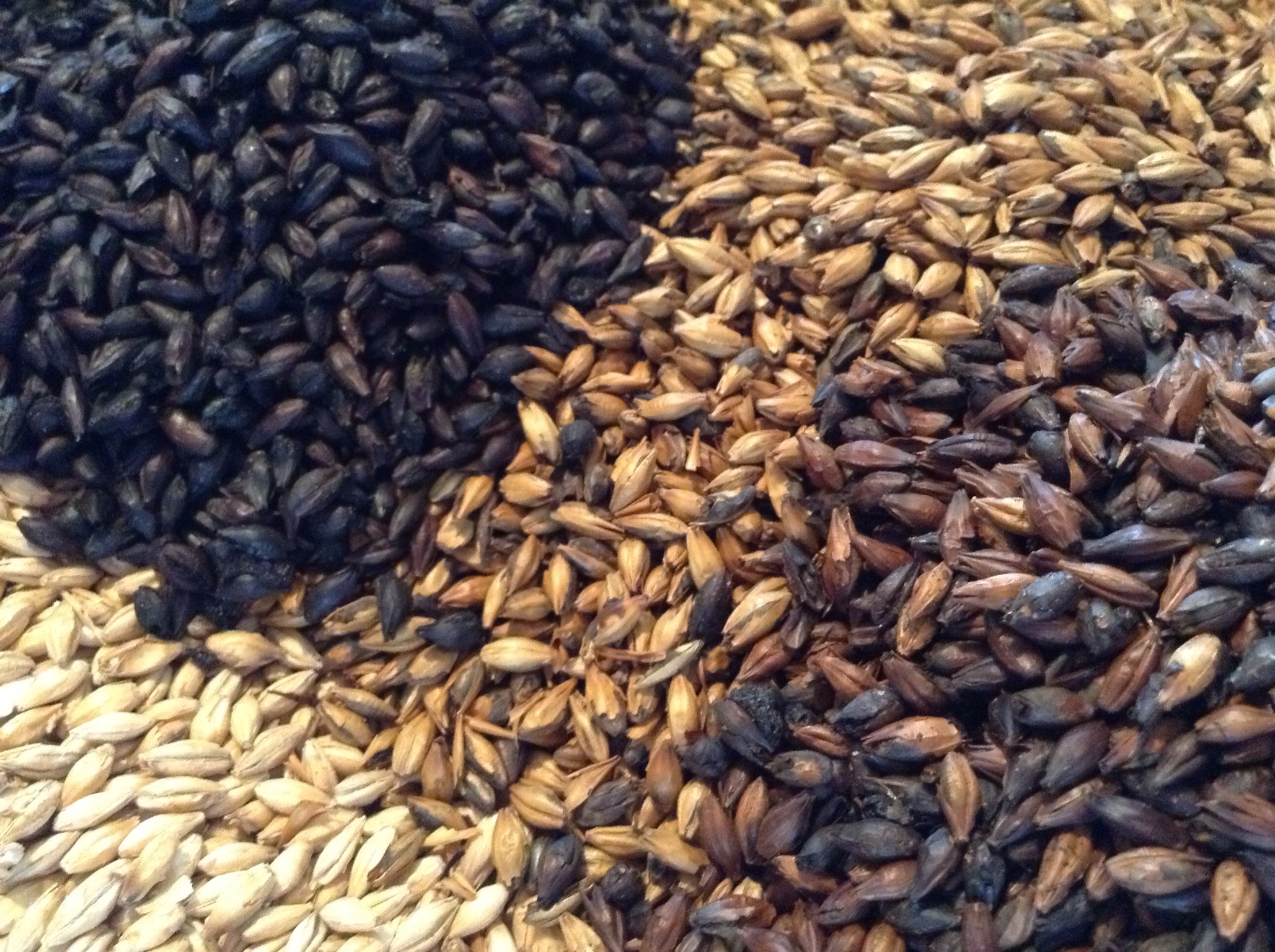
Different kinds of malt
(Photo from CervezArte)
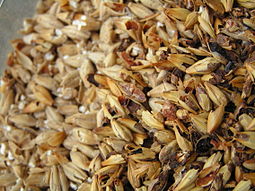
Daily Apple readers may also recall that I showed you this picture of Crystal Malt, which is one of many kinds of malt (or malted barley) that can be used in making beer.
(Photo from Wikipedia)

How a barley kernel changes during the malting process. Left: barley corn at the start. Middle: green malt. Right: finished or browned malt
(Photo from Oregon State University)

Here, the transformation is a little more obvious. This is green malt. You can clearly see the growth starting on these grains of barley. I'm guessing that those little shootlets drop off once the green malt is heated and dried and turned into actual malt.
(Photos from the Maltsters' Association of Great Britain)

The malting "tower" at Burton-on-Trent, owned by Molson Coors Brewing UK.
(Diagram from the Maltsters' Association of Great Britain)

Malted milk powder, today sold by King Arthur Flour
(Photo from Kitchen Lore)

Crates of Horlicks Malted Milk to be taken on Admiral Byrd's second Antarctic expedition in 1933.
(Photo from the Wisconsin Historical Society)

Chocolate malted milkshake
(Photo and recipe from the Food Network)
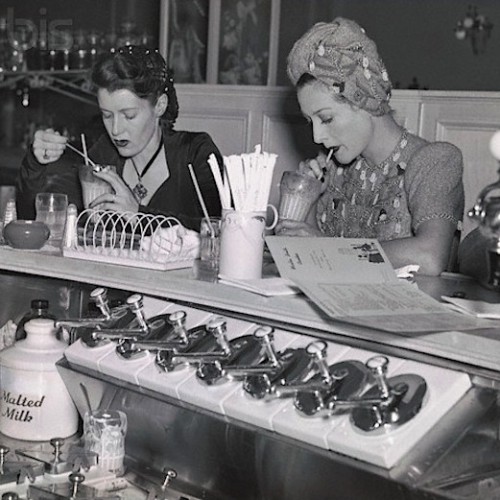
Milkshakes at the malt shop.
(Photo from nahchural on Tumblr)
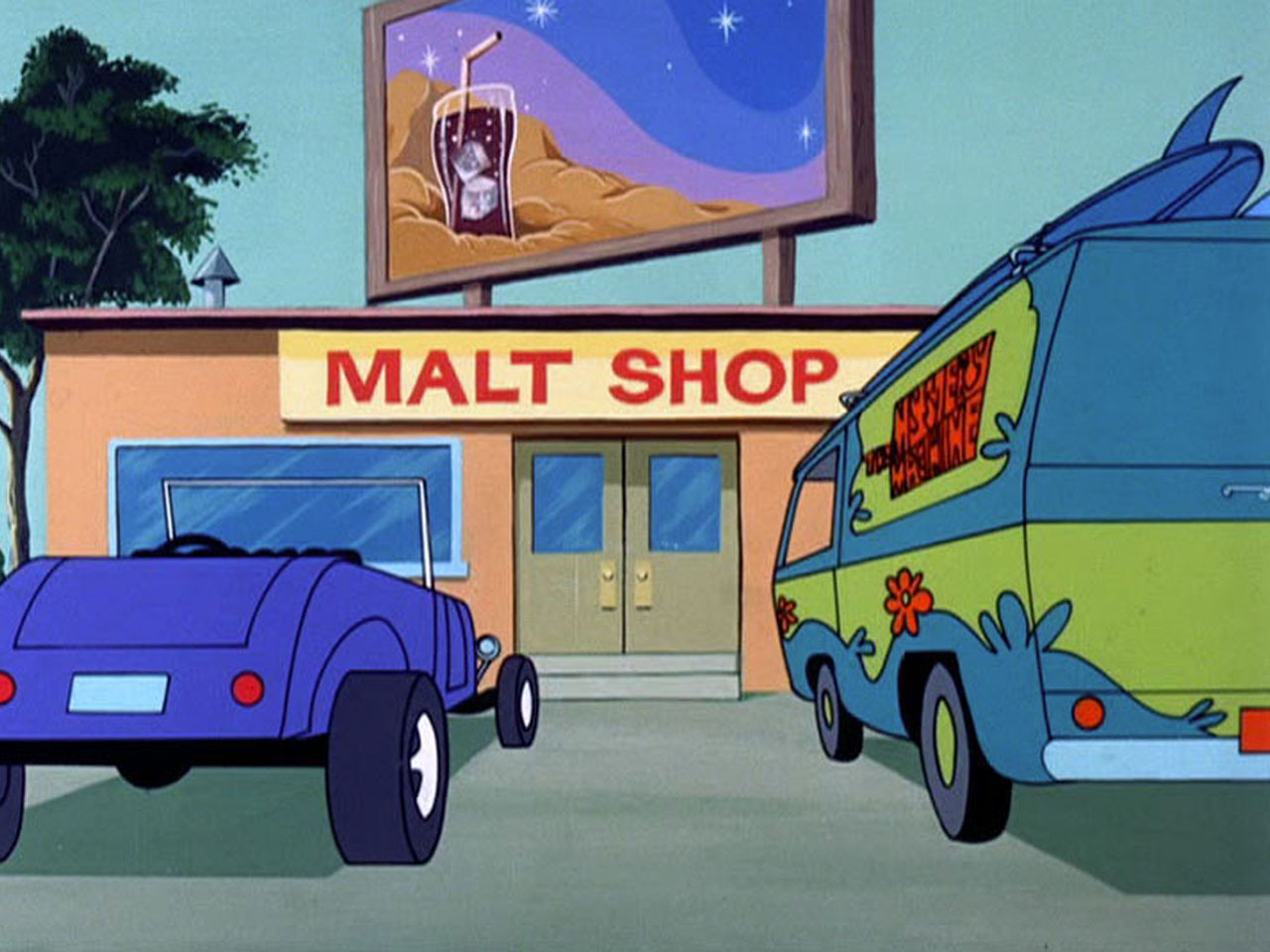
I couldn't resist. Just had to put this in here.
(Scooby-Doo still from Malt Shop Tumblr)

Malted milk balls. The stuff that's in here is the same stuff that's used to make beer -- malt.
(Photo from Nuts.com)

I think that's all the malt-including products. Or at least, it's all the mainstream US ones that I can think of.
In spite of the popularity of so many different malted milk products, most malt is used to make brewed and distilled beverages.
There. That's my story. And I'm sticking to it.
Sources
The Maltsters' Association of Great Britain, How Malt is Made
Oregon State University, Barley: Quality factors for malting, brewing, and other end-uses
Malt Madness, A Beginner's Guide to Single Malt Whiskey, Chapter 2, Vocabulary
Food Republic, What Is Malt Vinegar?
Wisconsin Historical Society, "That's Meat and Drink to Me" Wisconsin's Malted Milk Story
Walgreen's, Our Past
WiseGeek, What is the Difference Between a Milkshake and a Malt?
Collecting Candy.com, A Walk Through Whoppers Packaging History, June 25, 2012
Livestrong, Malt-O-Meal vs. Oatmeal
Malt-O-Meal, Original cereal Nutrition Facts, Have a Question?
This is a good question because malt is one of those mysterious ingredients that seems to be in all sorts of things -- beer, vinegar, milkshakes, whiskey -- but nobody seems to know what the heck it is.
Malt!! What is it? Why does it exist...who put in in milkshakes? Why is it in whiskey?!?
I'm going to say right up front that there's probably no way I'll be able to find out who first put malt in milkshakes. That's like trying to identify the person who invented cheese, or who first had the brilliant idea to put peanut butter and jelly on the same sandwich. It happened so long ago, and the brilliance wasn't immediately recognized, and it wasn't until after everyone else was eating cheese, or peanut butter & jelly sandwiches, that people thought to say, "Who was the genius that came up with this?" By then it was too late and nobody knew.
I predict the same will be true, alas, of identifying the first person to put malt in milkshakes, or in anything.
But as for the rest of Maximilian's question, I give you: malt.

Different kinds of malt
(Photo from CervezArte)
What Is Malt?
- Faithful Daily Apple readers may remember first encountering malt on these esteemed pages in the sleeper of an entry titled Beer Styles and Hoppiness. Malt is a key ingredient in the production of beer.
- Malt, as we learned then, is barley that's been allowed to germinate and barely to sprout and then it's dried so the growth process is halted right there. Its name in formal circles is "malted barley," but most people just call it "malt."
- In this newly sprouted stage, the barley possesses the greatest amount of sugar that the plant will ever have in its lifetime. If you're making beer, this is exactly what you want--the most sugar possible. Because yeast loves sugar, and you want to give yeast as much sugar as you possibly can in order to get the best, most fermenty result.

Daily Apple readers may also recall that I showed you this picture of Crystal Malt, which is one of many kinds of malt (or malted barley) that can be used in making beer.
(Photo from Wikipedia)
- So that information was pretty brief, as far as understanding malt goes. There's more to the story of malt than that.
- First, there are lots of different kinds of malt. Malted barley is the kind used most often. But you can also have malted wheat or malted rye or malted oats or malted rice.
- Your choice of which type of grain you use to make malt will depend on what you're making, and on what part of the world you're from. In Iran and a few other Middle Eastern countries, they love their malted wheat. In Finland, they go for the malted rye and eat it like porridge.
- Whatever grain you prefer, if you want to make malt out of it, there's a recommended series of steps to get from a kernel of grain to the malt:
- Dry the grains
- Store them until the seeds are asleep and won't grow 'til you tell them to. Takes about 6 weeks.
- Soak the grains in water and take them out, soak them again and take them out over the course of 2 or 3 days. This tells the grains time to start sprouting.
- When the grains hit 46% moisture--see how long people have been doing this? They know the optimal moisture content down to the exact percentage--take them out of the water and dry them. This is done by constantly turning the grains in a room with a lot of hot air. This takes about 5 days. At this stage, it's called green malt.
- The green malt is then dried further, or browned, to whatever amount of dryness or color you want. Then it's officially malt.
- People have been growing barley and wheat for about 12,000 years, and malting is thought to have been done for at least 6,000 years. The malting process is done these days in batches of 20 to 100 tons of grain.

How a barley kernel changes during the malting process. Left: barley corn at the start. Middle: green malt. Right: finished or browned malt
(Photo from Oregon State University)
- The top photo is what barley looks like before malting, the bottom photo is after. Doesn't look much different, does it? But if you look closely, you'll notice that the malt is slightly lighter in color, the pointy ends are kind of breaking open slightly. If you could eat the two, then you'd really notice the difference. The barley is hard, difficult to bite into, little to no flavor. The malt, on the other hand, is softer and you'd taste the malt flavor immediately.

Here, the transformation is a little more obvious. This is green malt. You can clearly see the growth starting on these grains of barley. I'm guessing that those little shootlets drop off once the green malt is heated and dried and turned into actual malt.
(Photos from the Maltsters' Association of Great Britain)
- Malting sounds like a simple process, but it's become very mechanized, and since it's done on such a large scale, the malting facilities are now enormous.

The malting "tower" at Burton-on-Trent, owned by Molson Coors Brewing UK.
(Diagram from the Maltsters' Association of Great Britain)
So far, I've only mentioned malt in terms of its use in making beer. But is that malted barley the same malt that's used in making other malt stuff? Answer: Yes.
The longer answer is that there are many, many types of malted barley. But when people say "malt," no matter what it's used in, they nearly always mean "malted barley."
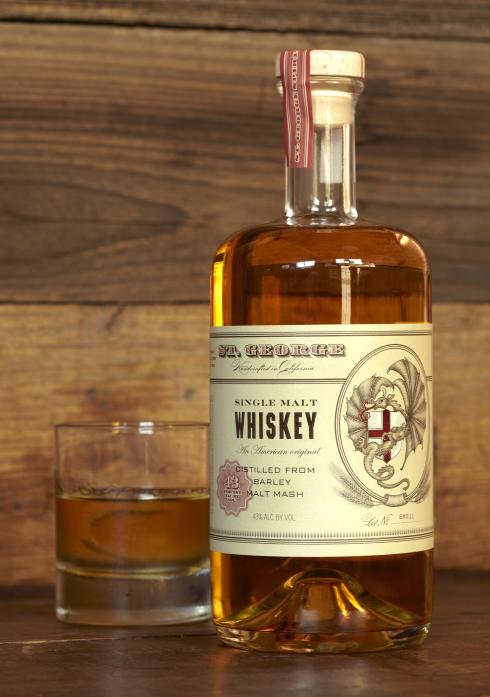
One example of a malt whiskey, specifically, a single malt whiskey. Which means it's made from 100% malted barley, no other grains, and from only one distillery.
(Photo from Cask Strength)

Malt vinegar. A longtime favorite on fish & chips (a.k.a. fries).
(Photo from Dine Delish)
The longer answer is that there are many, many types of malted barley. But when people say "malt," no matter what it's used in, they nearly always mean "malted barley."
Malt Whiskey
- Here again, the malt used in making whiskey is the same as the malt used in making beer.
- Technically speaking, "malt whiskey" means that it's made from 100% malted barley. No other types of grains -- wheat, maize, or unmalted barley) were used to make it. Some whiskey aficianados will only drink malt whiskey, never grain whiskey.
- The word "single" in "single-malt whiskey," by the way, doesn't really have anything to do with the malt. It means that the whiskey came from one distillery. It could have come from many different pots within the distillery, but all comes from the same distillery. As opposed to "Vatted Malt Whiskey," in which case the malt whiskey could have come from many different distilleries.

One example of a malt whiskey, specifically, a single malt whiskey. Which means it's made from 100% malted barley, no other grains, and from only one distillery.
(Photo from Cask Strength)
Malt Vinegar
- Malt vinegar begins with our same malted barley. Then it's added, not to vinegar as you might expect, but to ale. (For the difference between ales and other types of beers, see Beer Styles and Hoppiness)
- The ale is allowed to ferment until it becomes vinegar. Then it's allowed to age, which gives it even more flavor.
- Voila! Malt vinegar. Very tasty on French fries.

Malt vinegar. A longtime favorite on fish & chips (a.k.a. fries).
(Photo from Dine Delish)
Malted Milk
- Malted milk is a powdered mixture that includes the malted barley we've seen above, plus powdered milk and wheat flour, and sometimes more sugar, though the malt usually contains enough sugar on its own. All that gets ground up together and sold as a powder. But where did malted milk powder come from?

Malted milk powder, today sold by King Arthur Flour
(Photo from Kitchen Lore)
- In 1869, a London pharmacist named James Horlicks wanted to make a nutritional supplement for infants and children. He came up with a combination of malted barley, ground wheat, and milk, and ground it all up into a powder so it wouldn't spoil. When you mixed it with milk, it made a tasty and nutritious drink.
- James didn't have enough money to make his powder on a large scale, so he did what any enterprising inventor would do: he moved to Wisconsin. His brother William was working in Racine, WI, in a quarry and making good money at it. So James joined him in Racine.
- By 1873, they had founded J & W Horlicks to make their malted milk powder. 10 years later, they had a patent for "granulated food for infants." Their malted milk powder became so popular, adults were drinking malted milk too.
- Expeditions to the North and South Poles took the malted milk powder along with them. Those explorers appreciated the shelf-stable, non-perishable, high-calorie food so much, Admiral Richard E. Byrd even named a mountain range in Antarctica after the Horlicks brothers. Eventually, James moved back to London and became a wealthy patron of Arctic expeditions.

Crates of Horlicks Malted Milk to be taken on Admiral Byrd's second Antarctic expedition in 1933.
(Photo from the Wisconsin Historical Society)
- Once malted milk became so popular, it was only a matter of time before people started trying it in other ways. Such as in milkshakes.

Chocolate malted milkshake
(Photo and recipe from the Food Network)
- Walgreen's pharmacy claims they were the first to make a malted milkshake, but if you read their history carefully, you can see that's actually not the case.
- The first Walgreen's pharmacy was built in Dixon, IL in 1901. By the 1920s, Walgreen's was serving hot food and soda fountain beverages, and they had expanded to 20 stores, most of them in Chicago.
- They say that in the summer of 1922, Ivar "Pop" Coulson (soda jerk?) mixed his special chocolate malted milkshake.
- You might be tempted to think this was the first malted milkshake ever, but Walgreen's says: "Until then, malted milk drinks were made by mixing milk, chocolate syrup and a spoonful of malt powder in a metal container, then pouring the mixture into a glass. On one especially hot summer day in 1922, Pop Coulson set off his revolution. To the basic mixture, he added a generous scoop of vanilla ice cream, then another."
- In other words, malted milk drinks existed before Pop Coulson mixed his special version. What was so special about his version, apparently, was that he added extra ice cream.
- Whoever was the first to make a malted milkshake, by the 1940s, they had become so popular, ice cream parlors were springing up that were called "malt shops."

Milkshakes at the malt shop.
(Photo from nahchural on Tumblr)

I couldn't resist. Just had to put this in here.
(Scooby-Doo still from Malt Shop Tumblr)
- By the way, the only difference between a malted milkshake and a regular milkshake is the malted milk powder. One or, at the most, two teaspoons of malted milk powder is enough per milkshake.
- This same malted milk powder also gets put into malted milk balls.

Malted milk balls. The stuff that's in here is the same stuff that's used to make beer -- malt.
(Photo from Nuts.com)
- The first malted milk balls were made in 1939, about 50 years after malted milk powder was invented, and right around the time when malted milkshakes were becoming popular.
Malt-O-Meal
- Malt-O-Meal was first made in 1919 as an alternative to oatmeal.
- Its primary ingredient is farina, which is the very middle part of the wheat kernel, without the bran or the germ. Next on the ingredient list is malted barley.

Malt-O-Meal. Yet another product made with malt.
(Photo from Malt-O-Meal)
I think that's all the malt-including products. Or at least, it's all the mainstream US ones that I can think of.
In spite of the popularity of so many different malted milk products, most malt is used to make brewed and distilled beverages.
There. That's my story. And I'm sticking to it.
Sources
The Maltsters' Association of Great Britain, How Malt is Made
Oregon State University, Barley: Quality factors for malting, brewing, and other end-uses
Malt Madness, A Beginner's Guide to Single Malt Whiskey, Chapter 2, Vocabulary
Food Republic, What Is Malt Vinegar?
Wisconsin Historical Society, "That's Meat and Drink to Me" Wisconsin's Malted Milk Story
Walgreen's, Our Past
WiseGeek, What is the Difference Between a Milkshake and a Malt?
Collecting Candy.com, A Walk Through Whoppers Packaging History, June 25, 2012
Livestrong, Malt-O-Meal vs. Oatmeal
Malt-O-Meal, Original cereal Nutrition Facts, Have a Question?
It's so important to realize that every time you get upset, it drains your emotional energy.
ReplyDeleteThank you to sharing very important information to us